Related Research Articles

Claudius Ptolemy was a mathematician, astronomer, natural philosopher, geographer and astrologer who wrote several scientific treatises, three of which were of importance to later Byzantine, Islamic and Western European science. The first is the astronomical treatise now known as the Almagest, although it was originally entitled the Mathematical Treatise and then known as The Great Treatise. The second is the Geography, which is a thorough discussion of the geographic knowledge of the Greco-Roman world. The third is the astrological treatise in which he attempted to adapt horoscopic astrology to the Aristotelian natural philosophy of his day. This is sometimes known as the Apotelesmatiká (Ἀποτελεσματικά) but more commonly known as the Tetrábiblos from the Koine Greek (Τετράβιβλος) meaning "Four Books" or by the Latin Quadripartitum.

The Ptolemaic dynasty, sometimes also known as the Lagids or Lagidae, was a Macedonian Greek royal family, which ruled the Ptolemaic Kingdom in Egypt during the Hellenistic period. Their rule lasted for 275 years, from 305 to 30 BC. They were the last dynasty of ancient Egypt.

Cleopatra VII Philopator was the last active ruler of the Ptolemaic Kingdom of Egypt. As a member of the Ptolemaic dynasty, she was a descendant of its founder Ptolemy I Soter, a Macedonian Greek general and companion of Alexander the Great. After the death of Cleopatra, Egypt became a province of the Roman Empire, marking the end of the second to last Hellenistic state and the age that had lasted since the reign of Alexander. Her native language was Koine Greek, and she was the only Ptolemaic ruler to learn the Egyptian language.
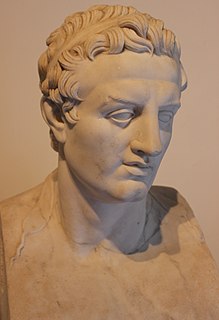
Ptolemy III Euergetes was the third king of the Ptolemaic dynasty in Egypt from 246 to 222 BC. The Ptolemaic Kingdom reached the height of its power during his reign.

Ptolemy I Soter was a companion and historian of Alexander the Great of the Kingdom of Macedon in northern Greece who became ruler of Egypt, part of Alexander's former empire. Ptolemy was pharaoh of Ptolemaic Egypt from 305/304 BC to his death. He was the founder of the Ptolemaic dynasty which ruled Egypt until the death of Cleopatra in 30 BC, turning the country into a Hellenistic kingdom and Alexandria into a center of Greek culture.
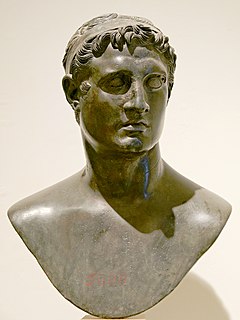
Ptolemy II Philadelphus was the pharaoh of Ptolemaic Egypt from 283 to 246 BC. He was the son of Ptolemy I Soter, the Macedonian Greek general of Alexander the Great who founded the Ptolemaic Kingdom after the death of Alexander, and queen Berenice I, originally from Macedon in northern Greece.
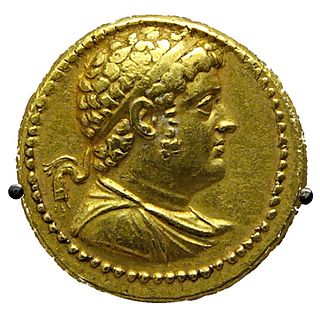
Ptolemy IV Philopator, son of Ptolemy III and Berenice II, was the fourth Pharaoh of Ptolemaic Egypt from 221 to 204 BC.
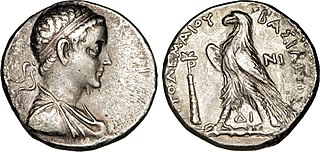
Ptolemy V Epiphanes, son of the siblings Ptolemy IV Philopator and Arsinoe III of Egypt, was the fifth ruler of the Ptolemaic dynasty from July/August 204 to September 180 BC.

Ptolemy VI Philometor was a king of Egypt from the Ptolemaic period. He reigned from 180 to 164 BC and from 163 to 145 BC. The eldest son of Ptolemy V Epiphanes and Cleopatra I of Egypt, he came to the throne as a very young child in 180 BC and the kingdom was governed by regents: his mother until her death in 178 or 177 BC and then two of her associates, Eulaeus and Lenaeus until 169 BC. From 170 BC, his sister-wife Cleopatra II and his younger brother Ptolemy VIII Euergetes were co-rulers alongside him.
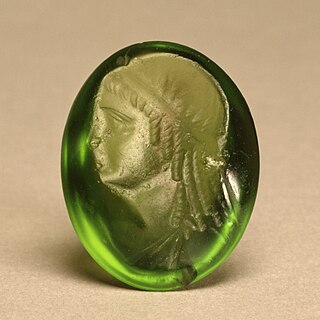
Cleopatra II was a queen of Ptolemaic Egypt who ruled from 175 to 116 BC with two successive brother-husbands and her daughter—often in rivalry with her brother Ptolemy VIII.
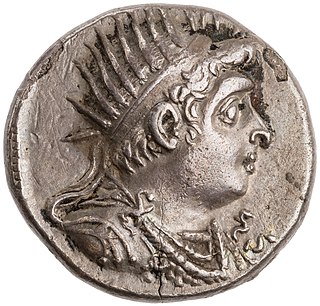
Ptolemy VIII Euergetes II Tryphon, nicknamed Physcon, was a king of the Ptolemaic dynasty in Egypt. He was the younger son of Ptolemy V Epiphanes and Cleopatra I Syra. His reign was characterised by fierce political and military conflict with his older brother Ptolemy VI Philometor and his sister Cleopatra II.

Ptolemy IX Soter II, commonly nicknamed Lathyros, reigned twice as king of Ptolemaic Egypt: first as Ptolemy Philometor Soter in joint rule with his Cleopatra II and Cleopatra III, and then again as Ptolemy Soter. He was the son of Ptolemy VIII and Cleopatra III.

Ptolemy X Alexander I was King of Egypt from 107 BC till his death in 88 BC, in co-regency with Cleopatra III as Ptolemy Philometor Soter until 101 BC, and then with Berenice III as Ptolemy Philadelphus. He was a son of Ptolemy VIII Physcon and Cleopatra III, and younger brother of Ptolemy IX. His birth name was probably Alexander.

The Dulgubnii are a Germanic tribe mentioned in Tacitus' Germania as living in what is today northwest Germany. Tacitus describes them being to the north of the Angrivarii and Chamavi, and as having moved from the north into the area once belonging to the Bructeri, between Ems, Lippe, and Weser. In this same area as the Dulgubnii, north of the Chamavi and Angrivarii, were the Chasuarii, and north of these, on the North Sea coast, where the Chauci. The Chasuarii's name is thought to derive from the River Hase which feeds into the middle of the Ems from the east, just northwest of the area associated with the Angrivarii, on the Weser. So from Tacitus, it appears that the Dulgubnii probably lived near the Weser.
The Banochaemae, Baenochaemae, Bainochaimai or Bonochamae were a Germanic tribe recorded only in the Geography of Claudius Ptolemy.
The Bateinoi or Batini were a Germanic tribe recorded by the Roman scholar Claudius Ptolemy. According to Ptolemy they were located "above" the Banochaemae tribe, who were settled near the upper Elbe, and "below" the Asciburgius mountain. That is all history knows for certain about them.
The Daukiones (Greek) or Dauciones (Latinization) were a Germanic tribe mentioned by Ptolemy (2.10) as living in Scandia, i.e. Scandinavia.

The Geography, also known by its Latin names as the Geographia and the Cosmographia, is a gazetteer, an atlas, and a treatise on cartography, compiling the geographical knowledge of the 2nd-century Roman Empire. Originally written by Claudius Ptolemy in Greek at Alexandria around AD 150, the work was a revision of a now-lost atlas by Marinus of Tyre using additional Roman and Persian gazetteers and new principles. Its translation into Arabic in the 9th century and Latin in 1406 was highly influential on the geographical knowledge and cartographic traditions of the medieval Caliphate and Renaissance Europe.

Crowsnest Range is a mountain range of the Rocky Mountains in southwestern Alberta and southeastern British Columbia, Canada.

The Ptolemaic Kingdom was an ancient Hellenistic state based in Egypt. It was founded in 305 BC by Ptolemy I Soter, a companion of Alexander the Great, and lasted until the death of Cleopatra in 30 BC. Ruling for nearly three centuries, the Ptolemies were the longest and final Egyptian dynasty of ancient origin.
References
- Ptolemy's Geography online
- Richard Talbert , Barrington Atlas of the Greek and Roman World , ( ISBN 0-691-03169-X ), Map 48.
| | This Italian history article is a stub. You can help Wikipedia by expanding it. |
| | This article about an ethnic group in Europe is a stub. You can help Wikipedia by expanding it. |